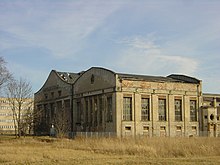Westvorstadt (Pirna)
|
West suburb
City of Pirna
Coordinates: 50 ° 57 ′ 40 ″ N , 13 ° 56 ′ 0 ″ E
|
|
|---|---|
| Height : | 120 m above sea level NN |
| Area : | 30 ha |
| Residents : | 2659 (Dec. 31, 2010) |
| Population density : | 8,863 inhabitants / km² |
| Postal code : | 01796 |
| Area code : | 03501 |
The Westvorstadt is a district of Pirna , the district town of the Saxon Switzerland-Eastern Ore Mountains district .
geography
The Westvorstadt is a suburb within the Pirna district , which is in front of the Pirna old town to the west. Its central, coherent built-up area lies on the left bank of the Elbe between Grohmannstrasse in the east, Königsteiner Strasse ( Bundesstrasse 172 ) in the south, Maxim-Gorki-Strasse in the west and the Dresden – Děčín railway line in the north. It is traversed by the Gottleuba, which flows into the Elbe immediately below the western suburb .
The Pirna city bridge connects the western suburb with the Copitz district on the opposite bank of the Elbe. In the northwest of the western suburbs are the Pirna train station and the bus station. This is a central public transport hub in the district. The listed Hengst furniture factory is also located in the Westvorstadt .
history
In the area of today's western suburb there was a loosely built settlement outside the Pirna city walls as early as the 15th century . It mainly consisted of individual garden and residential houses with extensive gardens. 1412 the "Nuwingaßin vor der stat" (today Klosterstrasse) is mentioned for the first time. In 1452 the Pirna Council bought the gardens of “Nuwegasse, Vogilgasse, Dresdenische and Breitegassen” from a gentleman from Bünau at Weesenstein Castle and received the interest in a document. Today, "Vogelgasse" is Gartenstrasse and " Dresdenische Gasse" is Bahnhofstrasse. Until the 19th century, the Westvorstadt was essentially limited to the area along these three streets. The Nieder- and Brethmühle also worked on the mill trenches fed by the Seidewitz and Gottleuba.
The main impetus for the further structural development of the Westvorstadt was the construction of the Pirna city bridge in 1872/75 and the associated relocation of the Pirna train station to its current location. The train station, located about 700 meters in front of the former city wall, formed a new point of reference for urban development. In 1886 the " Westvorstadt development plan " was presented, which provided for the construction of a road network up to the industrial areas in the corridors of the neighboring communities of Heidenau , Großsedlitz and Kleinsedlitz, which were also emerging .
Based on this development plan, intensive building activity from the Wilhelminian period began in the 1890s . The existing, individually standing residential and garden houses have largely given way to block perimeter development . In the vicinity of the station there was a separation and loosening of the buildings in the form of free-standing villa-like buildings. Externally, the houses are characterized by a wealth of forms from historicism , and there are also some Art Nouveau elements . The facades are richly decorated with sandstone and brick . The wrought iron fences of the villas are also typical.
The construction of the Gottleubabrücke on Maxim-Gorki-Straße was important for the traffic development of the Westvorstadt. With the construction of the bridge, a continuous connection was created from the Elbe bridge over the train station to Königsteiner Strasse / Dresdner Strasse (today Bundesstrasse 172 ). The Hengst furniture factory was built on Maxim-Gorki-Straße in 1899/1900 on the site of the Brethmühle , and today, together with the Elbe Valley headquarters, it is the most important structural evidence of industrialization in Pirna. With the breakthrough of Jacobäerstrasse (named after the pharmacist Theophilus Jacobäer ), the Westvorstadt received a direct connection to the historic old town in 1891 .
The buildings fell into disrepair during the GDR era. The state and party leadership at the time promoted their own new construction projects instead of committed to maintaining the buildings, for example on the Sonnenstein . Only after the fall of the Wall was it possible to save numerous buildings from further deterioration through extensive renovation measures.
Individual evidence
- ^ A b Alfred Meiche : Historical-topographical description of the Pirna administration. Dresden 1927, p. 240
- ↑ Rene Misterek: Pirna as it was. Droste Verlag, Düsseldorf 1996, p. 44
literature
- Eva Hilbrich: Old Street Names - The Garden Street . in: Pirnaer Official Journal 6/1991, pp. 74-75.
- Rene Misterek: Pirna the way it was . Droste Verlag, Düsseldorf 1996.
Web links
- Brief information about Gartenstrasse, the main shopping street in Westvorstadt ( Memento from July 6, 2007 in the Internet Archive )




